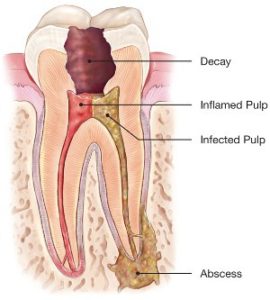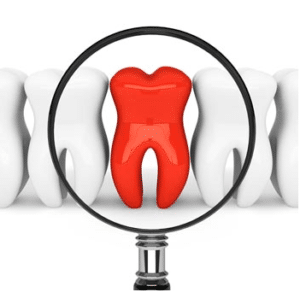Root Canal has developed quite a negative reputation over the years, as it is often associated with an extremely high level of pain among other negatives. The professionals here at Rockefeller Cosmetic Dentistry have decided to answer common questions regarding the Root Canal treatment, and debunk the various myths that are so commonly associated with this procedure!
What is a Root Canal / Root Canal Treatment?
The root canal is considered to be the pulp-filled cavity in the root of a tooth. When the pulp (soft tissue) inside the root canal of a tooth becomes infected or inflamed, the patient will begin to experience extreme discomfort or pain. The tooth may even become abscessed. Once the infection reaches the pulp, the nerve structure of the tooth immediately begins to die.
Root Canal treatment sets out to save the infected tooth and prevent it from further damage. During the treatment, anesthetic is injected around the infected area. Soon after, the restoration process begins. The core of the tooth is filled with a strong material. This process is called “core build up,” which is typically followed by the placement of a crown. These two steps provide a solid, long lasting core and protective cover for the tooth. In some instances, however, a crown is not needed.
How To Tell It’s Time for Root Canal Treatment?
Pain. Pain is the tell-tale warning sign that Root Canal treatment may be in your near future. When pain persists, it is time to acknowledge that this treatment is necessary in order to avoid further complications. In addition to severe tooth pain, there are other signs pointing towards a necessary Root Canal. These signs include, but are not limited to the following:
- Discoloration of infected tooth
- Prolonged sensitivity
- Gum swelling
- Persistent or recurring gum pimples
What Was The Cause Of Infection?
You may begin to wonder how the pulp inside the root canal of your tooth could become infected. There are many causes for the infection and inflammation of the soft tissue, some of which include but are not limited to the following:
- Poor oral hygiene
- Repeated dental procedures on the tooth
- Untreated cavities
- Broken teeth, cracks in enamel, exposed roots
- Gum disease and more
Debunking the Root Canal Myth
You may be under the impression that root canal treatments are all around terrible. Not only will we explain why root canals aren’t so bad; we will explain why they are the best decision you can make when it comes to an infected or abscessed tooth.
Myth #1: It is always best to have a tooth pulled rather than to receive a root canal treatment.
If you have the option to save your tooth, would you take advantage of it? Of course! If you can keep the real deal, it is highly suggested to try. Root Canal treatments have a high success rate when performed by doctors who are experienced in Root Canal treatments.
Myth #2: Root Canal treatment is extremely painful!
Anesthetic combined with the latest technology in dentistry only correlates to one thing: It’s a breeze! The pain you will experience from the infected or abscessed tooth will far exceed the mild discomfort you will experience during and post root canal.
Myth #3 Root Canal treatment makes you highly susceptible to illness.
There are no statistics proving this to be true, despite what the Internet may claim about root canal induced illness. Besides, there is nothing modern medicine can’t fix. It’s in your best favor to make the decision to save your tooth.
Rockefeller Cosmetic Dentistry
Call us at (212) 851-1091 or request a root canal consult here. Now that the myths have been debunked, have no fear! A painless solution to saving your tooth is just a call or click away.
If you believe you are in need of an emergency root canal, click here for more information on our emergency dental services.
In addition, the requirement for this treatment can be prevented by visiting your dentist regularly. Be sure to schedule a dental check-up with us twice per year. Let’s work together to keep up with your oral hygiene!






 Although a root canal is not typically an emergent situation, sometimes severe toothaches and mouth pain can severely affect your primary dental functions, making it extremely painful to eat, talk, or smile. If this is the case, you may be suffering from an acute tooth pulp disease and require an emergency root canal.
Although a root canal is not typically an emergent situation, sometimes severe toothaches and mouth pain can severely affect your primary dental functions, making it extremely painful to eat, talk, or smile. If this is the case, you may be suffering from an acute tooth pulp disease and require an emergency root canal.